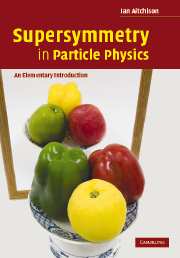Book contents
- Frontmatter
- Contents
- Preface
- Acknowledgements
- 1 Introduction and motivation
- 2 Spinors: Weyl, Dirac and Majorana
- 3 Introduction to supersymmetry and the MSSM
- 4 The supersymmetry algebra and supermultiplets
- 5 The Wess–Zumino model
- 6 Superfields
- 7 Vector (or gauge) supermultiplets
- 8 The MSSM
- 9 SUSY breaking
- 10 The Higgs sector and electroweak symmetry breaking in the MSSM
- 11 Sparticle masses in the MSSM
- 12 Some simple tree-level calculations in the MSSM
- References
- Index
1 - Introduction and motivation
Published online by Cambridge University Press: 05 September 2012
- Frontmatter
- Contents
- Preface
- Acknowledgements
- 1 Introduction and motivation
- 2 Spinors: Weyl, Dirac and Majorana
- 3 Introduction to supersymmetry and the MSSM
- 4 The supersymmetry algebra and supermultiplets
- 5 The Wess–Zumino model
- 6 Superfields
- 7 Vector (or gauge) supermultiplets
- 8 The MSSM
- 9 SUSY breaking
- 10 The Higgs sector and electroweak symmetry breaking in the MSSM
- 11 Sparticle masses in the MSSM
- 12 Some simple tree-level calculations in the MSSM
- References
- Index
Summary
Supersymmetry (SUSY) – a symmetry relating bosonic and fermionic degrees of freedom – is a remarkable and exciting idea, but its implementation is technically rather complicated. It can be discouraging to find that after standard courses on, say, the Dirac equation and quantum field theory, one has almost to start afresh and master a new formalism, and moreover one that is not fully standardized. On the other hand, 30 years have passed since the first explorations of SUSY in the early 1970s, without any direct evidence of its relevance to physics having been discovered. The Standard Model (SM) of particle physics (suitably extended to include an adequate neutrino phenomenology) works extremely well. So the hardnosed seeker after truth may well wonder: why spend the time learning all this intricate SUSY formalism? Indeed, why speculate at all about how to go ‘beyond’ the SM, unless or until experiment forces us to? If it's not broken, why try and fix it?
As regards the formalism, most standard sources on SUSY use either the ‘dotted and undotted’ 2-component (Weyl) spinor notation found in the theory of representations of the Lorentz group, or 4-component Majorana spinors. Neither of these is commonly included in introductory courses on the Dirac equation (although perhaps they should be), but it is perfectly possible to present simple aspects of SUSY using a notation which joins smoothly on to standard 4-component Dirac equation courses, and a brute force, ‘try-it-and-see’ approach to constructing SUSY-invariant theories. That is the approach to be followed in this book, at least to start with.
- Type
- Chapter
- Information
- Supersymmetry in Particle PhysicsAn Elementary Introduction, pp. 1 - 15Publisher: Cambridge University PressPrint publication year: 2007

